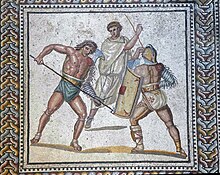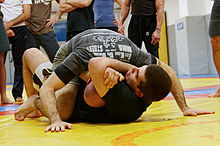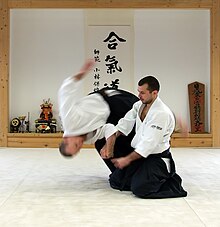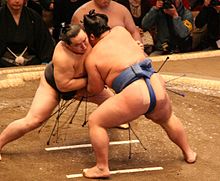Portal:Martial arts
The Martial Arts Portal

Martial arts are codified systems and traditions of combat practiced for a number of reasons such as self-defence; military and law enforcement applications; competition; physical, mental, and spiritual development; entertainment; and the preservation of a nation's intangible cultural heritage. (Full article...)
Although the earliest evidence of martial arts goes back millennia, the true roots are difficult to reconstruct. Inherent patterns of human aggression which inspire practice of mock combat (in particular wrestling) and optimization of serious close combat as cultural universals are doubtlessly inherited from the pre-human stage and were made into an "art" from the earliest emergence of that concept. Indeed, many universals of martial art are fixed by the specifics of human physiology and not dependent on a specific tradition or era.
Specific martial traditions become identifiable in Classical Antiquity, with disciplines such as shuai jiao, Greek wrestling or those described in the Indian epics or the Spring and Autumn Annals of China. (Full article...)
Selected articles
Selected biography
Robinson was a dominant amateur, but his exact amateur record is not known. It is usually listed as 85–0 with 69 knockouts, 40 in the first round. However it has been reported he lost to Billy Graham and Patsy Pesca as a teenager under his given name, Walker Smith Jr. He turned professional in 1940 at the age of 19 and by 1951 had a professional record of 129–1–2 with 85 knockouts. From 1943 to 1951 Robinson went on a 91-fight unbeaten streak, the sixth-longest in professional boxing history behind Pedro Carrasco with 93, Jimmy Wilde with 95, Buck Smith with 102, Packey McFarland with 104, and Young Griffo with 107. Robinson held the world welterweight title from 1946 to 1951, and won the world middleweight title in the latter year. He retired in 1952, only to come back two-and-a-half years later and regain the middleweight title in 1955. (Full article...)
Selected entertainment
Mortal Kombat is an American media franchise centered on a series of fighting video games originally developed by Midway Games in 1992.
The original Mortal Kombat arcade game spawned a franchise consisting of action-adventure games, a comic book series, a card game, films, an animated TV series, and a live-action tour. Mortal Kombat has become the best-selling fighting game franchise worldwide and one of the highest-grossing media franchises of all time.
The series has a reputation for high levels of graphic violence, including, most notably, its fatalities, which are finishing moves that kill defeated opponents instead of knocking them out. Controversies surrounding Mortal Kombat, in part, led to the creation of the Entertainment Software Rating Board (ESRB) video game rating system. Early games in the series were noted for their realistic digitized sprites and an extensive use of palette swapping to create new characters. Following Midway's bankruptcy, the Mortal Kombat development team was acquired by Warner Bros. Entertainment and re-established as NetherRealm Studios.
Sports portals
Selected image
 |
The épée (English: /ˈɛpeɪ/ or /ˈeɪpeɪ/, French pronunciation: [epe]), sometimes spelled epee in English, is the largest and heaviest of the three weapons used in the sport of fencing. The modern épée derives from the 19th-century épée de combat, a weapon which itself derives from the French small sword.
As a thrusting weapon, the épée is similar to a foil (contrasted with a sabre, which is designed for slashing). It has a stiffer blade than a foil. It is triangular in cross-section with a V-shaped groove called a fuller. The épée also has a larger bell guard designed to protect the user’s arm. In addition to the larger “bell” guard and blade, the épée weighs more than the foil and sabre which contributes to its reputation of being the slowest form of fencing. The techniques of use differ, as there are no rules regarding priority and right of way. Thus, immediate counterattacks are a common feature of épée fencing. The entire body is a valid target area. (Full article...)
General images -
Selected quote
Topics
- Regional origin - China - Europe - India - Indonesia - Japan - Korea - Philippines
- Unarmed techniques - Chokehold - Clinch - Footwork - Elbow strike - Headbutt - Hold - Kick - Knee strike - Joint lock - Punch - Sweep - Takedown - Throw
- Weapons - Archery - Duel - Knife fighting - Melee weapons - Shooting - Stick-fighting - Swordsmanship
- Training - Kata - Practice weapon - Punching bag - Pushing hands - Randori - Sparring
- Striking - Boxing - Capoeira - Karate - Kickboxing - Muay Thai - Lethwei - Sanshou - Savate - Taekwondo - Vovinam
- Internal - Aikido - Aikijutsu - Baguazhang - Tai chi - Xing Yi Quan
- Full contact / Combat sports - Professional boxing - Professional kickboxing - Knockdown karate - Mixed martial arts - Pankration - Submission wrestling
- Self-defense / Combatives - Arnis - Bartitsu - Hapkido - Kajukenbo - Krav Maga - MCMAP - Pencak Silat - Systema - Wing Chun - Legal aspects
- Eclectic / Hybrids - American Kenpo - Chun Kuk Do - Jeet Kune Do - Shooto - Shorinji Kempo - Unifight
Categories
Things you can do
See the list on the right of Martial art related projects who organise work on these articles. You can also add your self to the list of Wikipedians by martial art
Talk page tagging
If you come across a martial arts related article, adding the project template {{WikiProject Martial arts}} to the talk page will help identify them for improvement and linking to related articles. For Boxing, Fencing, Mixed martial arts and Sumo. Use {{WikiProject Boxing}}, {{WikiProject Fencing}}, {{WikiProject Mixed martial arts}} and {{WikiProject Sumo}} respectively.
- Assessment
- If possible please assess articles you tag using guidelines (Boxing, Mixed martial arts and Sumo).
Deletions
Monitor and contribute to deletion debates (Boxing).
Find images
Wikipedia requested images of martial artists, mixed martial artists and boxers.
Associated Wikimedia
The following Wikimedia Foundation sister projects provide more on this subject:
-
Commons
Free media repository -
Wikibooks
Free textbooks and manuals -
Wikidata
Free knowledge base -
Wikinews
Free-content news -
Wikiquote
Collection of quotations -
Wikisource
Free-content library -
Wikiversity
Free learning tools -
Wikivoyage
Free travel guide -
Wiktionary
Dictionary and thesaurus
- Pages with Portuguese IPA
- Pages with Japanese IPA
- Automatically maintained portals with listed maintainers
- Portals with triaged subpages from July 2019
- All portals with triaged subpages
- All portals
- Portals with named maintainer
- Automated article-slideshow portals with less than 2 articles in article list
- Random portal component with 16–20 available subpages
- Pages with French IPA
- Random portal component with 16–20 available image subpages
- Martial arts portal
- Martial arts
- Portals needing placement of incoming links






















































































